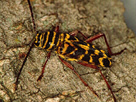
Examples of mimics, fakes and frauds are numerous in nature and new ones are still being discovered. To look like someone or something else provided it is of some advantage to the deceiver is the name of the game.
The term mimicry is commonly applied to the resemblance of one insect (called the mimic) to another (called the model) so that a third insect or other observer is deceived into confusing the two. In 1862 an entomologist conducting research in the Amazon found that many palatable (good tasting) species of insects derived protection by virtue of their similarity to unpalatable (bad tasting or poisonous) species. For example tasty female mocker swallowtails may mimic one of several poisonous species of butterfly, including the black and white Friar butterfly or the orange and black African monarch. Thus, two mocker swallowtails may look very different from one another. In an interesting twist, male mocker swallowtails never mimic other species.
Patterns and structures on butterfly wings may mimic many things. Scientists have recently suggested that the patterns on the edges of butterfly wings resemble caterpillars. When a bird pecks at what it sees as a larva, it targets the edge of the wing and allows the butterfly to break away. Hairstreak butterflies have false antennae and spots on the rear of their wings. Birds peck at the wrong end in an attempt to grab the head, and once again the butterfly can tear away and escape.
Other insects also use mimicry to their advantage. For instance, there is a moth that mimics the leg movements and threat postures of a spider, and a spider that mimics both the appearance, movements and color of a stinging, distasteful ant.
Because honey bees are able to defend themselves with a sting, animals usually leave them alone. Many other insects mimic bees and wasps. They presumably benefit from the fact that potential predators will mistake them for bees and leave them alone. Honey bee mimics are often fuzzy and brown, while wasp mimics are often bright yellow-and-black.
Some examples of insects that mimic bees and wasps are:
Flies (bee flies, hover flies, flower flies)
Beetles (black-and-yellow locust borer, hairy buprestid beetles)
Moths (some of the clearwing moths like the hornet moth)
Upon investigation, there are several different types of mimicry.
Batesian mimicry occurs when the model is more highly defended than the mimic. An example of Batesian mimicry is when the yummy viceroy butterfly mimics the orange and black coloration of the distasteful monarch butterfly. Birds that have learned to avoid eating monarchs will avoid eating viceroys as well. In Arizona the harmless bright red, black and white Baja Mountain kingsnake and the milksnake both mimic the poisonous red and black coral snake.
Mullerian mimicry occurs when the mimic is also well-defended. An example of Mullerian mimicry is the distasteful queen butterfly that is orange and black like the equally unpalat able monarch.
Speed mimicry occurs when a sluggish, easy to catch prey species resembles fast moving or hard to catch species that predators have given up trying to catch.
Wasmannian mimicry occurs when the mimic resembles it's host (the model) in order to live within the same nest or structure. For example, several beetles closely resemble ants. The ants provide them with food, shelter and protection and can not distinguish them from other colony members.
